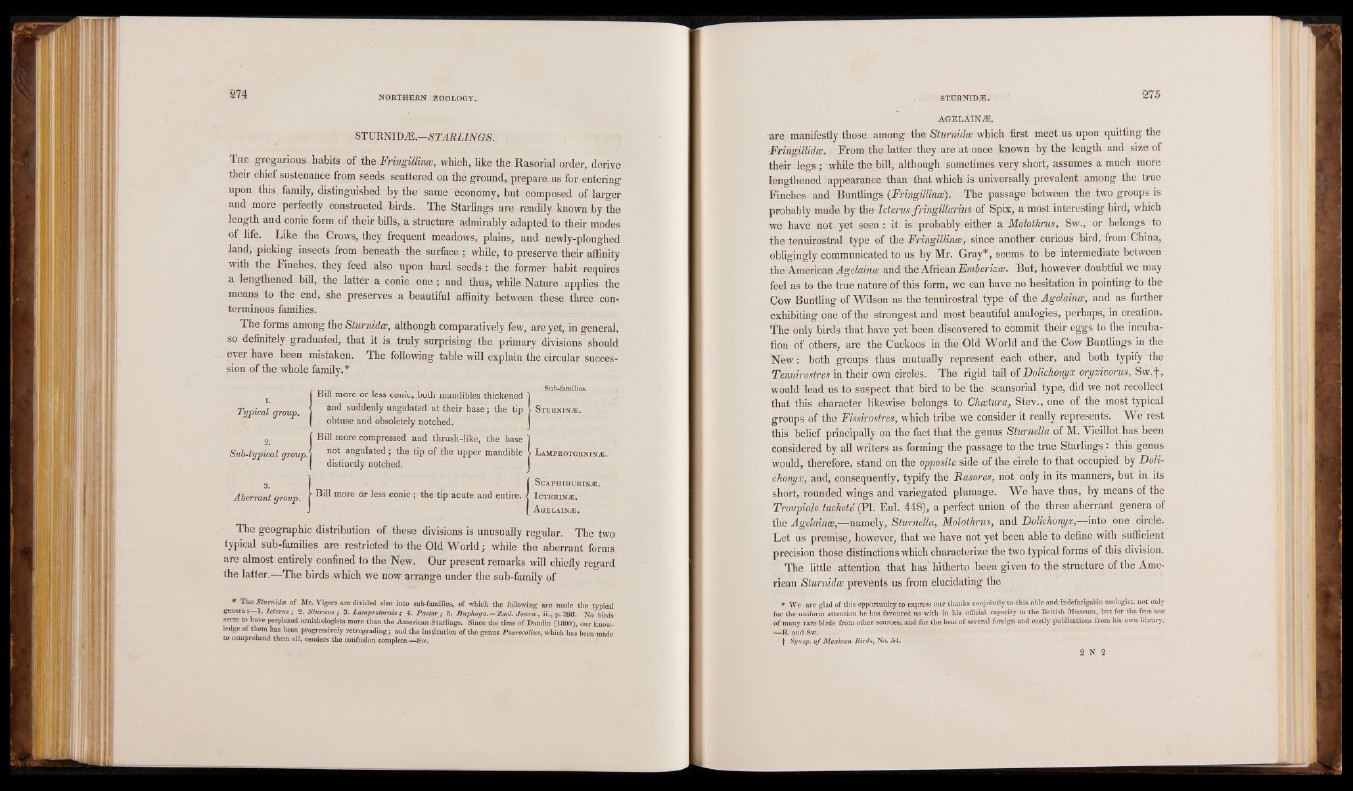
STURNIDAS.—STARLINGS.
The gregarious habits of the Fringillinw, which, like the Rasorial order, derive
their chief sustenance from seeds scattered on the ground, prepare us for entering
upon this family, distinguished by the same economy, but composed of larger
and more perfectly constructed birds. The Starlings are readily known by the
length and conic form of their bills, a structure admirably adapted to their: modes
of life. Like the Crows, they frequent meadows, plains, and newly-ploughed
land, picking insects from beneath the surface ? while, to preserve their affinity
with the Finches, they feed also upon hard seeds: the former habit requires
a lengthened bill, the latter a conic one; and thus, while Nature applies the
means to the end, she preserves a beautiful affinity between terminous families. these three conThe
forms among the Sturnidw, although comparatively few, are yet, in general,
so definitely graduated, that it is truly surprising the primary divisions should
seivoenr ohfa tvhee bweheonl e mfaismtailkye.*n. The following table will explain the circular succes1
f Bill more or less conic, both mandibles thickened
Typical group, j and 5nddenIy angnlated at their base ; the tip
( obtuse and obsoletely notched.
2 [ Bill more compressed and thrush-like, the base
Sub-typical group A not anSu^ate(^ 5 H i f e °f the upper mandible l Lamprotornin^.
( distinctly notched. I
3# I [. ScAPHIDURINdE.
Aberrant group. ( BlU more or less con!c i the t;P acute and entire, j Icterin*.
J ( Age lai nas.
The geographic distribution of these divisions is unusually regular. The two
typical sub-families are restricted to the Old World; while the aberrant forms
are almost entirely confined to the New. Our present remarks will chiefly regard
the latter.—The birds .which we now arrange under the sub-family of
* The Stumida of Mr. Vigors are divided also into sub-families, of which the following are mode the typical
genera;—1. Icterus; 2. Stumus ; 3. Lamprotom.it; 4. Pastor ; 5. Bnphaga.-Zool. Journ., ii., p. 398. No birds
seem to have perplexed ornithologists more than the American Starlings. Since the time of Daudin (1800), our know-
lteod cgoem opf rtehheemnd h tahse mbe eanll ,p rreongdreesrssi vtehley croentrfougsiroand icnogm; palentde. _th_eS win.stitution of the genus Ptarocolim, which haB been made
AGELAIIOE,
are manifestly those among the Sturnidw which first meet us upon quitting the
Fringillidw. From the latter they are at once known by the length and size of
their legs; while the bill, although sometimes very short, assumes a much more
lengthened appearance, than that which is universally prevalent among the true
Finches and Buntlings (Fringillince). The passage between the two groups is
probably made by the Icterus fringiUarius of Spix, a most interesting bird, which
we have not yet seen it is probably either a Molothrus, Sw., or belongs to
the tenuirostral type of the Fringillince, since another curious bird, from China,
obligingly communicated to us by Mr. Gray*, seems to be intermediate between
the American Agelaince and the African Emberizw. But, however doubtful we may
feel as to the true nature of this form, we can have no hesitation in pointing to the
Cow Buntling of Wilson as the tenuirostral type of the Agelaince, and as further
exhibiting one of the strongest and most beautiful analogies, perhaps, in creation.
The only birds that have yet been discovered to commit their eggs to the incubation
of others, are the Cuckoos in the Old World and the Cow Buntlings in the
New; both groups thus mutually represent each other, and both typify the
Tenuirostres in their own circles. The rigid tail of Dolichonyx oryzivorus, Sw.-)-,
would lead us to suspect that bird to be the scansorial type, did we not recollect
that this character likewise belongs to Chwtura, SteV., one of the most typical
groups of the Fissirostres, which tribe we consider it really represents. We rest
this belief principally on the fact that the genus Sturnella of M. Vieillot has been
considered by all writers as forming the passage to the true Starlings: this genus
would, therefore, stand on the opposite side of the circle to that occupied by Dolichonyx,
and, consequently, typify the Rasores, not only in its manners, but in its
short, rounded wings and variegated plumage. We have thus, by means of the
Troupiale tachete (PI. Enl. 448), a perfect union of the three aberrant genera of
the Agelaince,—namely, Sturnella, Molothrus, and Dolichonyx,—into one circle.
Let us premise, however, that we have not yet been able to define with sufficient
precision those distinctions which characterize the two typical forms of this division.
The little attention that has' hitherto been given to the structure of the American
Sturnidw prevents us from elucidating the
* We are glad of this opportunity to express our thanks conjointly to this able and indefatigable zoologist, not only
for the uniform attention he has favoured us with in his official capacity in the British Museum, but for the free use
of many rare birds from other sources, and for the loan of several foreign and costly publications from his own library.
—R. and Sw.
f Synop. of Mexican Birds, No. 54.
2 N 2